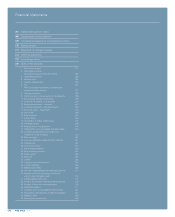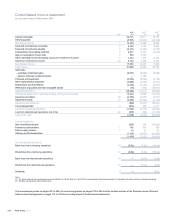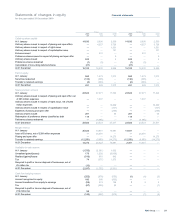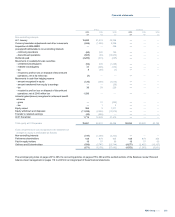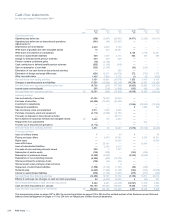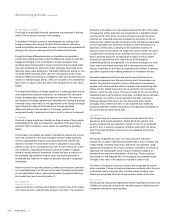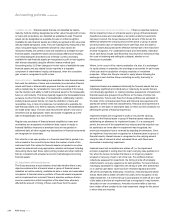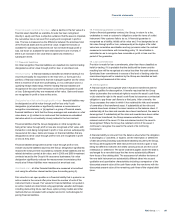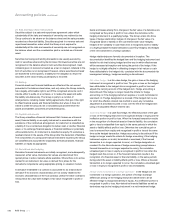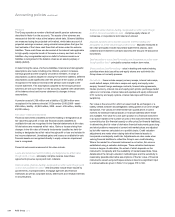RBS 2010 Annual Report Download - page 277
Download and view the complete annual report
Please find page 277 of the 2010 RBS annual report below. You can navigate through the pages in the report by either clicking on the pages listed below, or by using the keyword search tool below to find specific information within the annual report.
1. Presentation of accounts
The accounts are prepared on a going concern basis (see page 232 of
the Report of the directors) and in accordance with International Financial
Reporting Standards issued by the International Accounting Standards
Board (IASB) and interpretations issued by the International Financial
Reporting Interpretations Committee (IFRIC) of the IASB as adopted by
the European Union (EU) (together IFRS). The EU has not adopted the
complete text of IAS 39 ‘Financial Instruments: Recognition and
Measurement’; it has relaxed some of the standard's hedging
requirements. The Group has not taken advantage of this relaxation and
has adopted IAS 39 as issued by the IASB: the Group's financial
statements are prepared in accordance with IFRS as issued by the IASB.
The Group has adopted the revised IFRS 3 ‘Business Combinations’ and
related revisions to IAS 27 ‘Consolidated and Separate Financial
Statements’ issued in January 2008 and also IFRIC 17 ‘Distributions of
Non-cash Assets to Owners’ and the IASB’s consequential amendments
to IFRS 5 ‘Non-Current Assets Held for Sale and Discontinued
Operations’ issued in December 2008. They apply to transactions on or
after 1 January 2010 and have not resulted in the restatement of
previously published financial information. There have been no material
acquisitions in the year. In accordance with IFRS 5, before and after the
amendment, the Dutch retail and other banking businesses that were
transferred to the Dutch State on 1 April 2010 have been recognised as
discontinued operations with consequent changes to the presentation of
comparative financial information.
There are a number of other changes to IFRS that were effective from 1
January 2010. They have had no material effect on the Group’s financial
statements: in April 2009, ‘Improvements to IFRS’ - making non-urgent
but necessary amendments to standards, primarily to remove
inconsistencies and to clarify wording; and amendments to IAS 39
‘Financial Instruments: Recognition and Measurement’ - limited changes
to IAS 39 issued in July 2008 clarified that (a) a one-sided risk can be
designated as a hedged risk i.e. an option can be used to hedge a risk
above or below a specified threshold and (b) inflation can be a hedged
risk but only if the cash flows include a specified inflation portion.
The company is incorporated in the UK and registered in Scotland. The
accounts are prepared on the historical cost basis except that the
following assets and liabilities are stated at their fair value: derivative
financial instruments, held-for-trading financial assets and financial
liabilities, financial assets and financial liabilities that are designated as at
fair value through profit or loss, available-for-sale financial assets and
investment property. Recognised financial assets and financial liabilities
in fair value hedges are adjusted for changes in fair value in respect of
the risk that is hedged.
The company accounts are presented in accordance with the Companies
Act 2006.
2. Basis of consolidation
The consolidated financial statements incorporate the financial
statements of the company and entities (including certain special purpose
entities) that are controlled by the Group. Control exists where the Group
has the power to govern the financial and operating policies of the entity;
generally conferred by holding a majority of voting rights. On acquisition
of a subsidiary, its identifiable assets, liabilities and contingent liabilities
are included in the consolidated accounts at their fair value. Any excess
of the cost (the fair value of assets given, liabilities incurred or assumed
and equity instruments issued by the Group plus any directly attributable
costs) of an acquisition over the fair value of the net assets acquired is
recognised as goodwill. The interest of minority shareholders is stated at
their share of the fair value of the subsidiary's net assets.
The results of subsidiaries acquired are included in the consolidated
income statement from the date control passes up until the Group ceases
to control them through a sale or significant change in circumstances.
Changes in interest that do not result in a loss of control are recognised
in equity.
All intra-group balances, transactions, income and expenses are
eliminated on consolidation. The consolidated accounts are prepared
using uniform accounting policies.
3. Revenue recognition
Interest income onfinancial assets that are classified as loans and
receivables, available-for-sale or held-to-maturity and interest expense on
financial liabilities other than those at fair value through profit or loss are
determined using the effective interest method. The effective interest
method is a method of calculating the amortised cost of a financial asset
or financial liability (or group of financial assets or liabilities) and of
allocating the interest income or interest expense over the expected life
of the asset or liability. The effective interest rate is the rate that exactly
discounts estimated future cash flows to the instrument's initial carrying
amount. Calculation of the effective interest rate takes into account fees
payable or receivable that are an integral part of the instrument's yield,
premiums or discounts on acquisition or issue, early redemption fees and
transaction costs. All contractual terms of a financial instrument are
considered when estimating future cash flows.
Financial assets and financial liabilities held-for-trading or designated as
at fair value through profit or loss are recorded at fair value. Changes in
fair value are recognised in profit or loss together with dividends and
interest receivable and payable.
Commitment and utilisation fees are determined as a percentage of the
outstanding facility. If it is unlikely that a specific lending arrangement will
be entered into, such fees are taken to profit or loss over the life of the
facility otherwise they are deferred and included in the effective interest
rate on the advance.
Fees in respect of services are recognised as the right to consideration
accrues through the provision of the service to the customer. The
arrangements are generally contractual and the cost of providing the
service is incurred as the service is rendered. The price is usually fixed
and always determinable. The application of this policy to significant fee
types is outlined below.
275RBS Group 2010
Financial statements
Accounting policies



